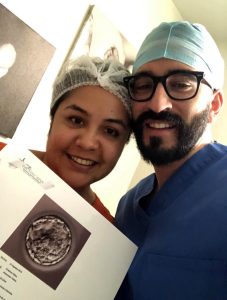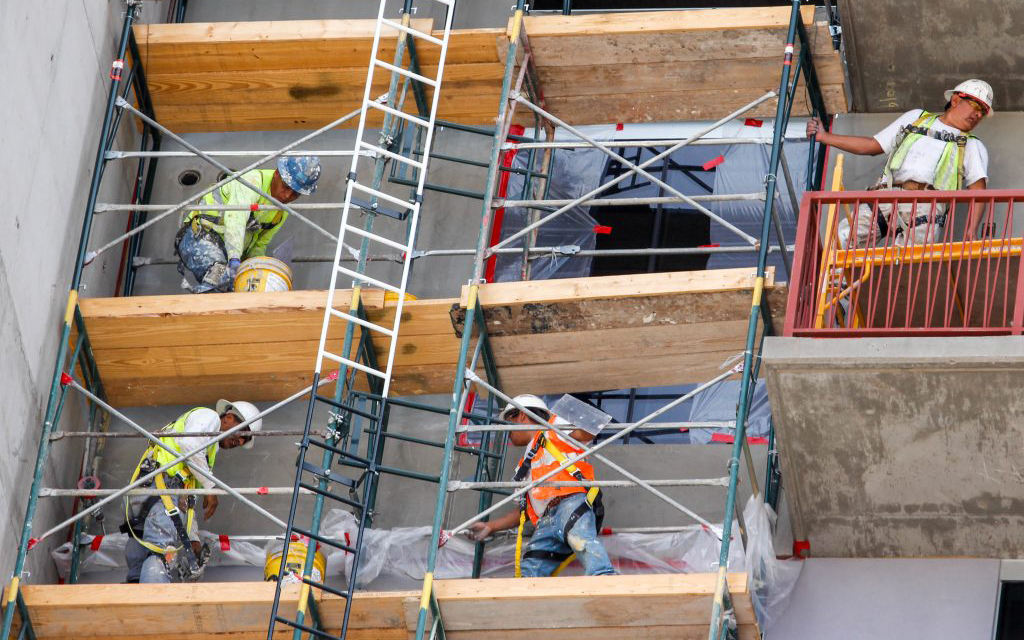Dec. 22, 2023Being ‘my own role model’: Normalizing mental health care in the AANHPI communityPHOENIX – For Jessika Malic, communications director of Asian Pacific Community for Action, a Phoenix-based nonprofit focused on providing access to health care, her search...
Dec. 22, 2023
Being ‘my own role model’: Normalizing mental health care in the AANHPI community
PHOENIX – For Jessika Malic, communications director of Asian Pacific Community for Action, a Phoenix-based nonprofit focused on providing access to health care, her search for the right mental health provider for herself involved some added effort. “I thought it would be great to see a woman of color, not even Asian,” Malic said. “My last two therapists were white women, which is not a problem, but also some of the things that I'm dealing with I think might be more relatable to someone of color.” Shela Yu, a Phoenix-based visual artist, has been seeking out mental health care since her teenage years. [caption id="attachment_223289" align="alignright" width="300"] Jessika Malic, communications director at Asian Pacific Community in Action in Phoenix, encourages “therapy in any form, as long as it’s not being used as an excuse to be bad or do bad things.” (Photo courtesy of Jessika Malic) [/caption]
“My mom came into my room one day. I might have been like, 13, or something like that, (I was) just sobbing for no reason.”
Though Yu’s mother suggested that her daughter see a therapist, Yu notes that when she was an adult, one of her younger family members reached out to her with a very different experience.
“Her parents are very anti-therapy.”
According to the Substance Abuse & Mental Health Services Administration’s 2021 National Survey on Drug Use and Health, a quarter of Asian American adults with mental illness had received mental health treatment in the past year. In that same timeframe, more than half of white Americans with mental illness received treatment.
For people seeking mental health care, reaching out and finding a provider can be a deeply personal experience. But for members of Asian American, Native Hawaiian and Pacific Islander communities, like Malic and Yu, broadly referred to as the AANHPI community, seeking mental health care can involve not just disclosing personal information, but also negotiating language barriers and cultural stigma from within their own personal histories.
Jessika Malic, communications director at Asian Pacific Community in Action in Phoenix, encourages “therapy in any form, as long as it’s not being used as an excuse to be bad or do bad things.” (Photo courtesy of Jessika Malic) [/caption]
“My mom came into my room one day. I might have been like, 13, or something like that, (I was) just sobbing for no reason.”
Though Yu’s mother suggested that her daughter see a therapist, Yu notes that when she was an adult, one of her younger family members reached out to her with a very different experience.
“Her parents are very anti-therapy.”
According to the Substance Abuse & Mental Health Services Administration’s 2021 National Survey on Drug Use and Health, a quarter of Asian American adults with mental illness had received mental health treatment in the past year. In that same timeframe, more than half of white Americans with mental illness received treatment.
For people seeking mental health care, reaching out and finding a provider can be a deeply personal experience. But for members of Asian American, Native Hawaiian and Pacific Islander communities, like Malic and Yu, broadly referred to as the AANHPI community, seeking mental health care can involve not just disclosing personal information, but also negotiating language barriers and cultural stigma from within their own personal histories.
Community stigma
One barrier that can prevent AANHPI individuals from seeking mental health care is the stigma associated with mental illness and mental health challenges in various AANHPI cultures. Max Lim, the on-site counselor for the University of Arizona’s Asian Pacific American Student Affairs Center, or APASA, said tenets of Confucianism, a philosophical tradition known for its veneration of family ties, can prevent some AANHPI college students of East or Southeast Asian descent from discussing mental health care. “What Confucianism taught us is to keep things within the family, because the family is the most important factor in this world,” Lim said. “And so sometimes when people do experience problems, they don't feel comfortable reaching out for help because it feels like you're going against the family … sharing your problems with an outsider.” [caption id="attachment_223288" align="alignright" width="227"] Jyothsna Bhat, a clinical psychologist based in New Jersey, says that engaging with South Asian community members and talking about how “mental health is not just a Western construct” normalizes conversations about mental health. (Photo courtesy of Jyothsna Bhat)[/caption]
Other people within the wider AANHPI community face stigma rooted in community perception. Jyothsna Bhat, a clinical psychologist in New Jersey, said that South Asians may avoid mental health care due to the fear of how they will be judged by their community.
“It's called ‘log kya kahenge,’ which means, ‘What will others think?’” Bhat said. ”It’s this idea of ‘We don’t want anyone to know, because if they hear, there’s going to be this feeling of judgment.’”
For immigrants, Bhat said, this fear of judgment creates stress, as immigrants facing mental health issues can think that they were “supposed to come here and create the perfect world,” but have fallen short because of their mental health.
Bhat also discussed the wider issue of the model minority myth, which affects several communities within the AANHPI umbrella. According to a document from the National Coalition for Asian Pacific American Community Development, this myth paints Asian immigrants as a “uniformly successful and highly educated but docile” minority, “...whose hard work and good attitude brings them economic success.” The document states that the myth was generated in the 1960s “by White Americans looking to discredit the demands of Black Americans by pointing to a ‘good’ minority group.”
According to Bhat, feeling the pressure to fit into the model minority myth can stop AANHPI people from viewing mental health care as a viable option.
“We have to come here and be a certain way. We have to be successful. That's what's expected of us,” Bhat said.
“We can't rock boats and we can't stir pots and we can't complain. … So then when it comes to something like mental health, it becomes problematic because that doesn't necessarily fit that mold.”
Jyothsna Bhat, a clinical psychologist based in New Jersey, says that engaging with South Asian community members and talking about how “mental health is not just a Western construct” normalizes conversations about mental health. (Photo courtesy of Jyothsna Bhat)[/caption]
Other people within the wider AANHPI community face stigma rooted in community perception. Jyothsna Bhat, a clinical psychologist in New Jersey, said that South Asians may avoid mental health care due to the fear of how they will be judged by their community.
“It's called ‘log kya kahenge,’ which means, ‘What will others think?’” Bhat said. ”It’s this idea of ‘We don’t want anyone to know, because if they hear, there’s going to be this feeling of judgment.’”
For immigrants, Bhat said, this fear of judgment creates stress, as immigrants facing mental health issues can think that they were “supposed to come here and create the perfect world,” but have fallen short because of their mental health.
Bhat also discussed the wider issue of the model minority myth, which affects several communities within the AANHPI umbrella. According to a document from the National Coalition for Asian Pacific American Community Development, this myth paints Asian immigrants as a “uniformly successful and highly educated but docile” minority, “...whose hard work and good attitude brings them economic success.” The document states that the myth was generated in the 1960s “by White Americans looking to discredit the demands of Black Americans by pointing to a ‘good’ minority group.”
According to Bhat, feeling the pressure to fit into the model minority myth can stop AANHPI people from viewing mental health care as a viable option.
“We have to come here and be a certain way. We have to be successful. That's what's expected of us,” Bhat said.
“We can't rock boats and we can't stir pots and we can't complain. … So then when it comes to something like mental health, it becomes problematic because that doesn't necessarily fit that mold.”
Language barriers
Beyond stigma, an additional barrier to mental health care for AANHPI people can be whether or not the provider is able to speak the client’s language. In 2022, according to Asian & Pacific Islander American Vote, a nonprofit organization promoting civic engagement, 74% of Arizona’s Asian American population spoke a non-English language at home, and nearly a third identified themselves as having limited English proficiency. APIA Vote also noted that a variety of Native Hawaiian and Pacific Islander languages were also spoken in Arizona in 2022, including Chamorro, Marshallese and Samoan. Nationally, 89% of psychologists surveyed by the American Psychological Association in 2021 could only provide services in English, while only 1% could provide services in Chinese, the only Asian language considered in the survey beyond “other languages not listed.” “Certain words, certain modes of expression are not necessarily easily translated in English,” Bhat said. Speaking a familiar, non-English language, or being able to switch from English to a more familiar language within the course of treatment, allows immigrants to be comfortable, Bhat said. Having to speak only English puts up a wall. “You're not able to really make your needs known in a way that's sort of fully authentic.” Lan Hoang, finance and operations director for Arizona Asian American Native Hawaiian and Pacific Islander for Equity Coalition, previously worked as a medical interpreter for the Vietnamese community in Irvine, California. Hoang’s start assisting her community with medical translations began with taking her grandmother to the doctor’s office. “She felt more comfortable with me taking her, versus my dad taking her,” Hoang said, noting that the Vietnamese people she translated for in Irvine became comfortable with her in a similar way. “They felt like I was their grandkid … When the doctors asked them questions, they felt comfortable enough to share their personal information with me and it made a big difference.” Some AANHPI people are skeptical, however, of the efficacy of medical interpreters in a mental health care setting. Dr. Chung Trinh, the CEO of Lighthouse Psychiatry Brain Health Center in Gilbert, said that stigma prevents fully honest disclosures in mental health care sessions even when an interpreter is present. “I've seen a couple times where there's an unwillingness to share more than they really need to share or want to share,” said Trinh, who notes that while he works with mental health clinicians, his role at Lighthouse Psychiatry Brain Health Center is administrative. “‘I have pneumonia’, that's pretty easy. But when you think about mental health … it's too intimate to really share with a stranger. And sometimes it's too scary to hear out loud, somebody explaining it to somebody else and you have no control over how that information is disseminated to a professional.” [caption id="attachment_223287" align="alignnone" width="1024"] Chung Trinh, CEO of Lighthouse Psychiatry Brain Health Center, speaks in his office on Nov. 29. His business focuses on improving the mental health of patients through various forms of care. (Photo by Kevinjonah Paguio/Cronkite News)[/caption]
Chung Trinh, CEO of Lighthouse Psychiatry Brain Health Center, speaks in his office on Nov. 29. His business focuses on improving the mental health of patients through various forms of care. (Photo by Kevinjonah Paguio/Cronkite News)[/caption]
Cultural competency
For members of the AANHPI community who, like Jessika Malic, communicate in English as their first language, providers don’t need to speak another language or have an interpreter on hand. Even if provider and client do share a language, however, a lack of cultural competency or understanding of the client’s cultural history can alienate the client from the provider, creating another barrier to care. When Mesa school counselor Makana Clarke searched for her own therapist, she said the hard part was “having to explain” things that would have made sense to a therapist who was born or lived in Hawaii. “It's hard to describe a culture in a 30-minute session or an hour at the most, I cannot explain certain things, because it's just innate. And so having to explain something as simple as ‘Oh, yeah, I missed my Auntie's funeral, and, you know, so and so is mad at me.’ You think lightly of that conversation,” Clarke said. “But somebody who was born and raised in Hawaii and understood the connection, the family ties, and all of those things, they would be like, ‘Well, yeah, this is jacked up – you didn't show any respect to Auntie So-and-so and their family is going to get mad because there's so much reciprocation, in our culture.’” For Max Lim, delivering culturally competent care to people in the AANHPI community, itself a large umbrella community made up of smaller ethnic groups, is a matter of remaining humble as well as informed. “It's just asking the client what they're most comfortable with (and) getting to know that person as an individual,” Lim said. “Yes, you do your homework on the culture in general, but also know that there are a lot of nuances. For me, it's always checking in with the client, ‘OK, what's most comfortable for you?’ and also practicing humility. Like, if you do something wrong or that rubs the client the wrong way, having that courage to talk about it, to apologize for it, own it.”Generational identity and mental health
Even while negotiating barriers to care, AANHPI people in Arizona, and the wider United States, contend with their own familial or personal histories of immigration. ”First-generation immigrants might be trying to navigate, say, visa issues or green card issues …,” said Euodia Moffitt-Chua, a psychologist and mental health advocate at UArizona's APASA. “Often they don't have a lot of people to reference for that. So there's isolation both on a societal level, but also on an individual psychological level.” The multicultural upbringing of second- or third-generation immigrants in the United States can, Moffitt-Chua said, contribute to a different kind of psychological isolation. “There's … family history that they're trying to navigate. So for example, maybe parents who speak a different first language,” she said. “Because, maybe historically, they (second- and third-generation immigrants) have been the person translating for their parents, helping their parents navigate certain systems in the United States. So they do a lot of code switching, like, ‘When I'm at home, I present this way, when I'm in school, I present this way with my peers.’ What does that mean in terms of having an integrated sense of the self?” Shela Yu, whose parents immigrated from Taiwan, experienced this kind of dual identity in her own life, having grown up Chinese American in Mesa. “Being a child of immigrants, you live these double lives,” Yu said. “You live this dual life of the culture from your parents at home … I was also trying to fit in with American culture and ‘90s culture at the time when I was at school.” Though generational struggles exist among Asian immigrants, the vocabulary to speak about them differs between generations. According to Lim, psychosomatic complaints of physical issues linked to mental health concerns are common in first-generation Asian immigrants. “A lot of people feel more comfortable going to their primary care physicians and talk(ing) about, you know, ‘I have a headache, I have a migraine or I'm not sleeping right or I have digestion issues.’ … For some of them, that is indicative of a mental health issue, but they just don’t have the vocabulary to express themselves.” Knowing this, Lim counsels Asian-American students at APASA to understand their parents and grandparents’ perspectives, reminding them that their older relatives may not be able to speak about mental health with a certain “understanding or awareness” or even see those needs as important when compared to others, like food and safety. Moffitt-Chua is optimistic that stigma has less of an effect on younger generations of AANHPI people. “In more senior generations, we do see stigma as a huge barrier to entry of care. A lot of people (feel) like if I go to a therapist, to a psychologist, it represents some weakness on my part. Like I can't figure things out on my own or I can't get my stuff together,” she said. In younger generations of AANHPI people, Moffitt-Chua said, “we're seeing a lot more accessing of care.” The 2021 National Survey on Drug Use and Health reported that 16.4% of Asian Americans and 18.1% of Native Hawaiians and Pacific Islanders over 18 had experienced mental illness. For AANHPI individuals aged 15 - 24, suicide was the leading cause of death, according to the Centers for Disease Control and Prevention. Trinh has also noticed more young AANHPI people seeking mental health care, but cautioned that this does not mean every young AANHPI person is unaffected by cultural stigmas passed down by family members. “We've had young people come in and say, ‘Well, I'm very old school.’ They're 25 and they're saying that they're old school, because they've adopted their generational experience coming down,” Trinh said. “Loosely speaking, yes, I think there is some difference that we're starting to see … in terms of adoption for mental health care for the younger ones, but it also really depends on their home structure.”Improving mental health access through normalization
To combat the barrier of stigma, Malic and others believe talking about mental health has to become normalized within AANHPI communities. “We need to see more people like us engaging in therapy, encouraging others, talking about their therapy experiences and mental health experiences,” Malic said. “It's out there, it's just not nearly as much as it could be.” For Trinh, normalizing mental health conversations starts at the dinner table, where he jokes that you can talk about “how bad the Cardinals are and how important mental health is within the same conversation.” Trinh’s openness about mental health with his family members – at and away from the dinner table – has helped them assist other members of the AANHPI community. “Recently, my mother called me,” Trinh said. “She brought up that one of her friends asked her about mental health challenges. Her friend's child actually suffers from … psychosis, and it's really challenging for that particular family because they just recently immigrated from their home country looking for a better life… And they had nowhere to go, they didn't know who to talk to. "Luckily, the parents were friends with my mother. And, you know, my mom, because I talk to my mom about mental health on a regular basis, she was able to kind of help them walk through some of the potential resources that they can get,” he said. Yu benefited from her mother’s openness and normalization of mental health care in a similar way. “My mom's a singer and a pianist. So my mom was very open to things, even though she still had this traditional mindset about some aspects,” Yu said. “One of her best friends was getting her Ph.D. in psychology while I was in high school. So she was familiar with some aspects of what it means to seek out therapy and wasn't against it.” For some, the next step to normalize conversations about mental health will involve engaging with community members and leaders directly. Trinh, for example, was a speaker at a 2023 mental health symposium with the city of Chandler. Having a presence and being able to work with community leaders in AANHPI communities, Trinh says, is especially important. “I think it really takes the leaders amongst the Asian community, to really step up and embrace the willingness for meaningful change. If they don’t do it – I can make as much noise as I can, but I'm a nobody, and I really can't do very much. But I think I challenge the leaders of our Asian community to make a meaningful difference.” “You got to meet the people where they’re at,” said Lim, who noted that his position as the site-based counselor for UArizona’s APASA Center means AANHPI students get to know him “outside of the therapy room.” Because of this, Lim said, they feel more comfortable seeking care from him later, should they need it. “Go into the communities, go into the community centers. And when you do offer … general health care checks and stuff like that for the community, maybe pairing it with a mental health clinician, they can help maybe address some of those issues as well.” Individually, AANHPI people are doing their part to continue talking about mental health with those willing to listen. “I need to be my own role model,” said Yu, who mentioned that she sometimes considers studying to become a counselor herself, having noted “a very limited pool of” qualified Asian American therapists. “Hopefully, that can be some guiding force for younger generations.” “Anytime anyone wants to talk about mental health, I'm there. I'm happy to talk about my own experience,” Malic said. “I can't advocate for everybody, but I hope that whatever I have to share might encourage someone else to go and seek help.” - Cronkite News is part of the Mental Health Parity Collaborative, a group of newsrooms that are covering stories on mental health care access and inequities in the U.S. The partners on this project include The Carter Center, The Center for Public Integrity (CPI) and newsrooms in select states across the country.













